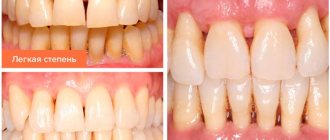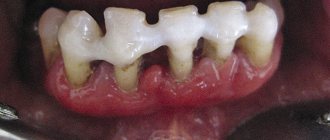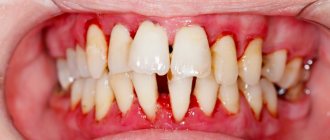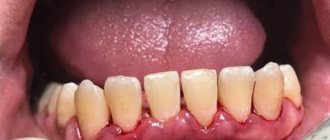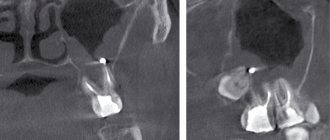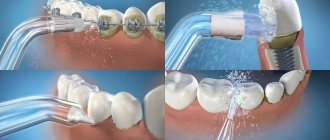Symptoms Classification of periodontitis Causes Possible complications How is it diagnosed?
Treatment Options Home Treatment Is Periodontitis Contagious? Recovery from severe periodontitis Differences from periodontal disease Prevention Periodontitis is an inflammatory periodontal disease that, without appropriate treatment, leads to destruction of the periodontal junction and tooth loss. It begins with inflammation of the gums, which occurs as chronic gingivitis. Subsequently, the pathological process affects deeper tissues, leading to the destruction of the periodontium, dental alveoli (socket), and the adjacent jawbone.
The tooth and periodontium are a single functionally and morphologically related system. The defeat of its individual elements disrupts the functionality of the dental unit, leads to disruption of the periodontal attachment, the formation of deep periodontal pockets, the formation of abscesses, fistulas on the gums, loosening, and tooth loss.
Symptoms
- Inflammation of the gums;
- hyperemia (redness) of the mucous membrane, swelling, reaction to temperature stimuli;
- sore gums;
- discomfort, bleeding gums when chewing, oral hygiene;
- detachment of the gum from the tooth wall;
- formation of periodontal pockets;
- abundant plaque and tartar around the tooth;
- pus from the gums;
- loosening of the gum edge;
- exposure of tooth roots;
- tooth mobility;
- inflammation of the submandibular lymph nodes
Symptoms of periodontitis vary depending on the extent of the inflammatory process. The more severe the stage of the disease, the more pronounced the symptoms. The disease does not occur suddenly; the early stage of periodontitis is catarrhal gingivitis - inflammation of the gums, not accompanied by a violation of the integrity of the mucous membrane.
Second stage of periodontal disease
At the second stage, degenerative processes are observed, provoking the release of pus in the gum pockets, the development of bleeding, and pronounced periodic gingivitis. A purulent process develops in the cavity of the pockets, the gum structure becomes loose, a whitish coating appears and the pericervical area is exposed. Gradually, tooth mobility and cracks in which food accumulates appear. There is pain when biting.
The middle stage indicates the development of periodontal disease, the roots are exposed by approximately 40-50%, interdental spaces and gum pockets are formed. Inflammatory processes periodically appear in the pockets with the release of pus.
Classification
Periodontitis is classified according to location, nature of the course, and severity.
According to the nature of the flow
There are acute and chronic forms. In the first situation, the signs of periodontitis are pronounced, the gums are loose, bleed, and hurt. If the patient does not consult a doctor or ineffective treatment is prescribed, the disease takes a chronic course. In the chronic form, the symptoms are smoothed out, there are no acute signs of inflammation, but the consequences are more severe. Chronic pathology is characterized by periodic exacerbations, when the symptoms become pronounced.
By localization
According to the distribution of the pathological process, periodontitis is divided into:
- Localized
(focal) - occurs in a small area, in the area of 1 or several teeth. - Generalized
periodontitis is inflammation of all or most teeth in a row.
The symptoms of localized and generalized forms of the disease are no different, the only difference is in the number of teeth around which the pathological process has spread.
Degrees of periodontitis
- Mild
– fiber disintegration of the compact plate, reduction of the interalveolar septum to 1/3 of the length of the tooth root, signs of osteoporosis, slight tooth mobility, periodontal pockets of 2.5-3.5 mm. - Medium
– the depth of periodontal pockets increases to 5 mm, moderate tooth mobility is observed (grades I-II), bone atrophy around the teeth reaches 1/2 of the roots. Exposure of the necks and roots of the teeth or inflammatory growth of the gums occurs, abscesses (abscesses in the gums) can form. The teeth begin to “diverge” under chewing pressure, and the gingival margin becomes deformed. This is especially noticeable in the area of the front incisors. The gums bleed when chewing or brushing teeth, the necks of the teeth are exposed, and react painfully to temperature stimuli. - Severe
– symptoms increase, exacerbations of chronic periodontitis in adults are accompanied by the formation of abscesses, severe swelling of the gums, and pain. The depth of periodontal pockets reaches 6 mm, right up to the root apex. The interdental spaces increase, there is strong tooth mobility (II-III degrees), bone resorption, up to complete resorption of the alveolar septum.
Depending on the individual characteristics of the body, the disease progresses differently. Aggressive forms of periodontitis are characterized by rapid, almost rapid destruction of periodontal tissue, loosening of teeth, and their painless loss. In another part of patients, the disease progresses slowly, with occasional exacerbations, and long remission.
The most severe form is necrotizing periodontitis.
, in which the gum tissue stops receiving nutrition, blood circulation in them stops, and necrosis of the periodontium, periodontal ligaments, and alveolar bone occurs. This form of the disease occurs in patients with severe immunodeficiency conditions (AIDS, DiGeorge syndrome, SCID, etc.).
Consequences.
The destruction of periodontal tissue affects the condition of the entire human body. In addition to the fact that the patient may lose all his teeth, he has a number of other problems. Most often, periodontal disease is accompanied by diseases of the digestive system, since the absence of several units and the presence of an inflammatory process do not allow complete chewing of food. In addition, a person begins to feel embarrassed about his smile; huge gaps between the teeth look very unattractive. Also, periodontal disease is dangerous for pregnant women, due to a sharp decrease in immunity and a lack of beneficial vitamins. To avoid complications, it is necessary to systematically undergo preventive examinations and not ignore the first signs of gum destruction and immediately seek help from a doctor.
Causes of periodontitis
A decisive role in the development of the disease is played by pathogenic microorganisms in dental plaque, which contribute to gum inflammation. The accumulating bacterial plaque hardens. Tartar builds up and penetrates deep into the gums, causing the mucous membrane to begin to peel off from the tooth, creating a free space that is gradually filled with pathogenic bacteria. Gingivitis develops, which without proper treatment quickly transforms into acute periodontitis.
Factors that provoke the development of periodontitis also include:
- regular injury to the gums due to incorrectly installed dentures and orthodontic systems;
- incorrect occlusion;
- accumulation of food particles and plaque under prosthetic and orthodontic structures;
- smoking and alcohol abuse;
- decreased immunity;
- physical trauma to teeth (impact);
- bruxism.
The development of chronic periodontitis can be influenced by problems with the gastrointestinal tract, endocrine disorders, blood diseases, vitamin deficiency, metabolic disorders, insufficient chewing load (the predominance of soft foods in the diet), autoimmune pathologies, and allergies to certain medications.
What it is?
Periodontal disease is very rare, affecting approximately 5-10% of the population and in older patients. The fact is that it does not develop in one day, but gradually, sometimes over 10-20 years. That is why its course is always chronic. It is quite difficult to identify this disease, due to the lack of visible symptoms; it can usually be diagnosed at later stages of formation. It is manifested by irritation of the gums, deterioration of the oral cavity, and destruction of bone tissue, subsequently leading to disruption of the functionality of the dental system. Only a specialist can determine the severity of periodontal disease, and he will prescribe a suitable course of therapy. But, before starting treatment, it is necessary to find out the main reasons for its occurrence.
Diagnostics
- Taking anamnesis;
- dental examination with measurement of the depth of periodontal pockets (periodontogram);
- orthopantomogram (OPTG), CT;
- rheoparodontography (assess the tone of blood vessels);
- Schiller-Pisarev test;
- microbiological studies (PCR);
- blood tests (general, sugar).
Differential diagnosis of periodontitis is carried out with gingivitis, eosinophilic granuloma of the jaw, periodontal changes in Lefebvre-Papillon syndrome. What examination methods will be required depends on the form and severity of the disease.
Treatment methods
Treatment includes a complex of local and general measures, prescribed individually, based on the results of the examination, according to the severity of the disease, the characteristics of its course, and general health. Effective comprehensive treatment of periodontitis is aimed at eliminating periodontal pockets, strengthening teeth and gums, and preventing the destruction of soft and hard tissues.
Hygienic cleaning
Regardless of the stage of the disease, the first stage of treatment is the removal of all dental plaque. For this purpose, special ultrasonic equipment is used, which allows you to carefully remove plaque and stone even in the most inaccessible places. After curettage (scraping) or ultrasonic cleaning performed using manual instruments, the gums are treated with an antiseptic, and medicinal dressings with an anti-inflammatory and antimicrobial agent are applied.
Drug therapy
For mild cases of the disease, local medications for periodontitis are prescribed (gels, ointments, rinses) that have anti-inflammatory, antimicrobial, and healing effects. In difficult cases, systemic antibiotic therapy, hormonal and antihistamine medications, and vitamin and mineral complexes are prescribed. Conservative treatment is effective at an early stage of the disease.
Preparations for the treatment of gum periodontitis have anti-inflammatory, analgesic, and antiseptic effects. The therapeutic effect is provided by using the drug as rinsing solutions, applications to the gums, tablets for oral administration, injections into the gums (vitamins, FiBS, aloe preparations, etc.). Course of treatment – from 2 to 4 weeks
at intervals of several days.
Physiotherapy
For the speedy elimination of the infectious focus and active tissue regeneration, additional physiotherapeutic procedures are prescribed - ultraphonophoresis, darsonvalization, ozone therapy, electrophoresis, gum massage, laser therapy. Localized periodontitis can be completely cured at an early stage without resorting to drastic measures. That’s why it’s so important to see a dentist at the first warning signs of illness.
Orthopedic treatment
During the treatment, orthopedic structures are corrected, parts of the fillings are removed from the interdental spaces, and crowns that have sunk deeply under the gum or are installed incorrectly are replaced. Splinting for periodontitis is indicated for degree II tooth mobility. Temporary splinting is carried out before curettage or immediately after it, permanent splinting is carried out a month after treatment.
Surgical methods
In severe cases of periodontitis, with deep periodontal pockets and defects of the gingival margin, in addition to conservative treatment, surgical treatment is required. Radical intervention involves cleaning the periodontal pockets with and without dissection of the gums, gingivectomy is an operation to remove inflamed, overgrown areas of the gums. The intervention involves reducing the volume of gum pockets and forming an aesthetic gingival margin. After the procedure, the natural process of tissue regeneration begins. When the alveolar septa are completely reabsorbed, excessively mobile, non-viable teeth are removed.
In case of significant destruction of the jawbone, when it cannot firmly hold the tooth in place, osteoplastic surgery is performed - directed bone regeneration. To do this, the area between the tooth and the bone is filled with a biocompatible osteoplastic material, which serves as a platform for the formation of new osteoblasts and restoration of bone volume.
Modern methods of treating periodontitis, such as laser and vector therapy, show impressive results. In just one procedure, gum pockets are reduced, swelling, pain, and bleeding disappear. Non-contact methods have a biostimulating effect and significantly accelerate tissue healing. Regardless of the severity of periodontitis, the correct occlusion is determined for all patients, and selective grinding of the teeth is carried out according to indications.
Purpose of the study
Development and scientific substantiation of the magnetic therapy technique at the stage of restorative treatment of patients with chronic generalized periodontitis (CGP). The results of observation of 60 patients aged 35 to 65 years with a diagnosis of moderate CGP are presented. Patients in the control group underwent pulsed carbon dioxide irrigation at an indifferent temperature for 12 minutes No. 10. Patients of the main group additionally underwent magnetic therapy No. 10 for 5 minutes on each side on the projection area of the upper and lower jaw using a labile technique. When analyzing the results of a clinical examination, the dynamics of periodontal and rheographic indices, it was established that a course of use of magnetic therapy in complex periodontal treatment makes it possible to eliminate foci of inflammation, achieve long-term stabilization of the periodontal condition, and restore the structural and functional properties of the elements of the periodontal complex.
Inflammatory periodontal diseases are a medical and social problem [1–3]. In Russia, the prevalence of these diseases in the main group of the working population (35–44 years old) is close to 100% [4]. Against the background of inflammatory periodontal diseases, microcirculation disorders occur, manifested by changes in tone, peripheral resistance, vascular elasticity, phenomena of venous stagnation, increased permeability of the vascular wall [3], and increasing depending on the clinical severity of the process and the severity of its clinical manifestations [5].
The main therapeutic measures for periodontitis should be aimed at stopping inflammation in the tissues and preventing the spread of the process [1]. Since destruction of the supporting tissues of the tooth occurs precisely during exacerbations, one of the main goals of treatment is to reduce the number and duration of periods of exacerbation and increase the duration of periods of remission [1, 6-8].
The use of magnetic therapy is recommended as the most adequate and accessible method in the complex treatment of inflammatory periodontal diseases to relieve free radical oxidation and involutive changes in connective tissue. Magnetic therapy is carried out to improve reparative processes and restore homeostasis of the periodontal complex. This method allows you to quickly relieve swelling, inflammation and pain [9, 10]. It is important to note that the use of magnetic therapy has proven itself in the complex treatment of somatically burdened patients [9].
Goal of the work
— development and scientific substantiation of magnetic therapy techniques at the stage of restorative treatment of patients with chronic generalized periodontitis (CGP).
Is it possible to treat at home?
Decoctions of medicinal herbs (tricolor violet, calendula, lingonberry leaf, calamus, oak bark) will help relieve symptoms of acute inflammation. But no amount of rinsing will get rid of supragingival, and especially subgingival dental plaque. Only professional hygienic cleaning at the dentist's office can handle this. Folk remedies in the form of formulations of hydrogen peroxide, soda and lemon will only aggravate the situation. But maintaining the condition of your gums after treatment at home is not only possible, but also necessary. The dentist will give you all the necessary recommendations on how to treat periodontitis at home.
Prevention of periodontal disease
Prevention of a disease such as periodontal disease should include a whole range of measures, including eating healthy, fortified foods, regular oral care, and visiting the dentist. You need to start with regular intake of microelements. You should first consult with a supervising physician, who can correctly assess the degree of mineral deficiency and advise taking supplements or following a diet. Such prevention will allow you to saturate the body with essential microelements and quickly restore tissue.
In addition, patients with periodontal disease should regularly visit their doctor and maintain oral hygiene:
- Teeth should be brushed twice a day, recommended after each meal;
- To clean the interdental space, you need to use a special dental floss;
- follow a special balanced diet;
- after eating, rinse with special antiseptic rinses;
- use toothpastes with an anti-inflammatory effect.
Periodontal disease also requires regular professional tartar removal, performed by a supervising physician. In this case, tartar will not have time to accumulate in a large volume, the gums will not be injured, which will speed up the cure of the disease and prevent the development of such a dangerous disease as periodontal disease.
How to restore teeth with severe periodontitis
In severe cases of the disease, the risk of losing a tooth or an entire row of teeth is very high. Tooth extraction for periodontitis is indicated in cases of excessive mobility, when the unit is barely held in the bone and moves in all directions around its axis. If it is impossible to save the tooth, orthopedic treatment is carried out - prosthetics supported by natural teeth or implants.
For single defects or restoration of a tooth segment, two-stage implantation with delayed loading is used. Implants are implanted after a course of gum treatment and restoration of bone volume. Bone parameters are restored through osteoplastic surgery. After new bone tissue is formed (after 6 months), implants are implanted, the prosthetic system is fixed after they have fused with the jaw bone ( after 3-6 months
). Treatment may take about a year.
In case of complete edentia, one-stage implantation methods with immediate loading demonstrate high efficiency. The ability to install implants in deep bone layers that are not subject to inflammation allows you to avoid osteoplasty and sinus lifting. Treatment will take no more than a week.
The third stage of periodontal disease
This stage indicates the appearance of tangible atrophy of a total nature, the necks are greatly exposed and there is a strong displacement and instability of the tooth. The pain is constant and aching, abscesses are private, gum pockets become large and deep. In the absence of appropriate treatment, tooth loss occurs (the process spreads to the entire jaw), and osteomyelitis develops.
At the last stage, also called acute, serious deterioration of the condition is observed. Typically, patients consult a doctor precisely during this period, when pain, inflammation, and pus discharge appear. Severe exacerbation is possible during the dystrophic-inflammatory form, combined with the generalized form. Severe cavity abscesses are observed, and general intoxication due to purulent accumulations is possible. This period is characterized by a rapid course, the result of the acute stage is tooth loss.
Differences between periodontitis and periodontal disease
| Periodontal disease | Periodontitis | |
| Pathogenesis | Systemic dystrophic periodontal disease | Infectious and inflammatory periodontal disease |
| Character of the course | Develops slowly, asymptomatically | Develops quickly, often recurs, symptoms clearly manifest themselves in the acute period |
| Causes | Mainly systemic pathologies of the body, hereditary predisposition | Poor hygiene, excessive bacterial plaque, tartar, malocclusion, jaw injuries |
| Prevalence | A segment of teeth or the entire dentition is affected | Inflammation is localized in the area of one, several teeth or affects the entire jaw |
| Inflammation and bleeding gums | Absent | Main features |
| Tooth mobility | Occurs when gum recession extends more than 1/2 the length of the tooth root | It is observed in the acute period of the disease, against the background of looseness, swelling, and bleeding of the gums. Disappears after treatment |
| Forecast | Requires constant, maintenance therapy. In moderate and severe forms, the process only needs to be stabilized. The overall prognosis is poor (tooth loss) | With timely treatment, complete recovery |
First stage of periodontal disease
At the first stage, degeneration of the alveolar processes is observed, which is accompanied by itching and burning in the gums, the appearance of persistent plaque, and increased sensitivity. There are no visible pathologies or inflammatory processes, but the teeth do not hurt or become loose.
The initial stage is also characterized by a burning sensation in the mucous membrane of the gums, which ceases to receive a normal supply of nutrients. This period is the most favorable for conservative treatment (not requiring surgical intervention).
Timely measures can minimize the consequences of the disease and prevent the transition to the second and third stages. At this stage, the teeth are firmly held, there are no gaps between them, and there is no exposure of the cervix. There is also no bleeding yet, but there is already tartar, which, even with regular professional cleaning, quickly accumulates again.
Unfortunately, the practically asymptomatic course causes the lack of early diagnosis. The disease occurs without itching and pain.

